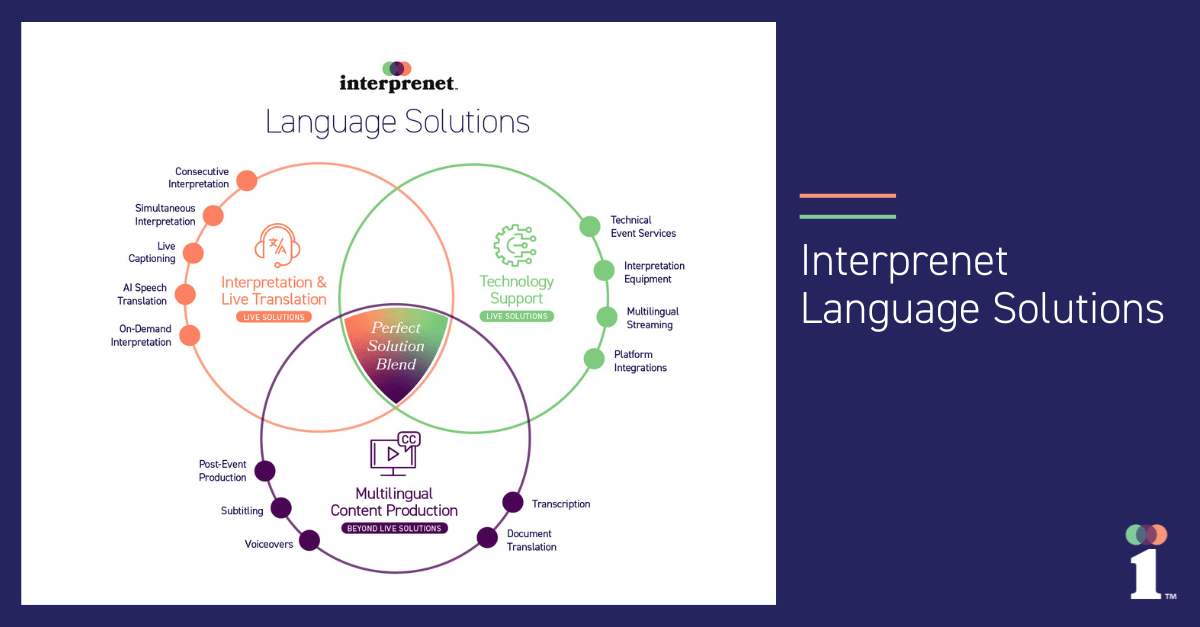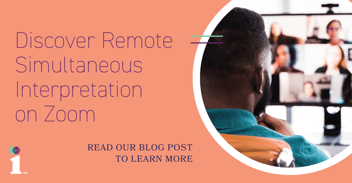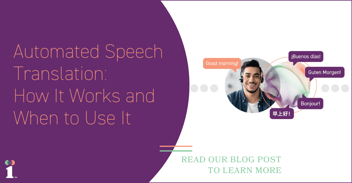
The way we live and work is changing, and that’s having a huge impact on the language services industry. Whether you’re already thinking about using remote simultaneous or consecutive interpretation in 2023 or you work at a company that needs multilingual captioning and translation, AI-powered technology is sure to affect language solutions going forward.
The future of language services is going to bring changes that require us to stay ahead of the game and predict where the industry is headed so that we can meet the demands of our clients.
We asked several Interprenet team members to share their top predictions for trends shaping the language services industry in 2023 and beyond. Read their trend forecast in this post.
Simultaneous interpretation services will grow
David Medrano, CEO
For 2023, we expect simultaneous interpretation services in North America to grow significantly. According to the 2023 Global Meetings and Events Forecast by AMEX GBT, 63% of respondents predict attendee numbers will return to 2019 levels in the next one to two years. More companies also choose to use simultaneous interpretation not only for in-person conferences but also for virtual events and meetings. This means the overall volume of simultaneous interpretation services in the US alone should grow by about 12% to 15% in 2023.
While AI solutions like machine-translated captions are getting better, they are no substitute for the accuracy and user experience that human captioners and interpreters provide. Simultaneous interpretation is also becoming increasingly cost-effective thanks to more flexible pricing models and seamless integrations with all communication platforms.
Demand for other language services provided by Interprenet, like translation, subtitles and on-demand interpretation including Over-The-Phone Interpretation, will continue to grow consistently by 5% to 10% annually, depending on the service. Technology will put pressure on language service providers to reduce their costs in a marketplace saturated with global competitors and strategic resellers operating on smaller profit margins.
DE&I will accelerate the need for interpretation
Kate Accetti, Senior Sales & Marketing Manager
The language services industry has had a mixed record over the last few years: fluctuations in trends, shifting of interpretation modalities due to safety measures during the COVID-19 pandemic (shifting in-person events to the virtual space ). By early 2022, people were planning in-person events again, only to change or cancel those plans when new health concerns arose.
From a global perspective, the language industry as a whole saw revenue growth and a total value upwards of $51 billion in 2021. In translation, advancements in AI, machine translation, and the rise of other smart tools have driven down costs and therefore increasing usage.
In the field of interpretation, Interprenet has seen an increase in serving virtual and hybrid events with interpretation solutions. In essence, the pandemic has made the world smaller and more connected. From our experience, we saw groups meeting virtually more often and with larger audiences because no travel is required to meet via Zoom, Google Meet, WebEx, or MS Teams. Now, as health and safety risks decrease, people are eager to return to in-person events and see people face-to-face again.
I recently attended a conference with over 1,000 attendees, and the buzzword among meeting planners was sustainability. The other pressing topic in business is diversity, equity, and inclusion. Considering these aspirations for organizations, I predict that interpretation for in-person and hybrid events will see another boom in 2023. By utilizing the combined power of technology and Remote Simultaneous Interpretation, people will continue to meet in person and have language access via cloud-based technology. In addition, the rise of holographic technology allows presenters and participants to join an in-person conference from a remote location, retaining the feeling of being present. These emerging technologies help businesses reduce their carbon footprint and cut costs as you save on lodging, equipment logistics, flights and more.
To further promote inclusion and diversity, translation will be used for more and more communications. By providing event registration pages, email invitations and meeting transcripts in multiple languages, organizers can increase response rates, and event attendance and engagement.
The integration of hybrid technologies will continue
Rich Douthit, Event & Technology Manager
At the risk of overstating the obvious, the last 24 months have changed everything. It’s undeniable that remote work has created a paradigm shift for the events industry. We have gotten used to hybrid meetings and conferences. The year 2022 has further solidified the hybrid trend, and I see the language services industry continuing to evolve as a result of this disruption.
2022 has seen events that simultaneously included virtual and in-person presenters, audiences, interpreters, technicians, and the varied technologies needed to facilitate these hybrid demands. Just two years ago, it was a novelty for a presenter to join a large in-person corporate event via Zoom from a remote location; but today it is an accepted norm. Similarly, an attendee at a hybrid event can listen to live interpretation via our language technology app, while their co-worker across the globe receives interpretation via live stream. 2022 has given the LSP industry and all service providers time to hone their services and create seamless and uninterrupted experiences for their multilingual audiences, both virtually and in-person.
For 2023, I see the need to create a ‘seamless sense of normalcy’ for all event attendees, involving multiple technologies and platforms. The future will bring a continuation of integration of hybrid technologies, with AI, ASR, and automated technologies coming in as efficient and cost-effective solutions.
So, what was once a linearly predictable meeting industry is now rapidly evolving beyond a grand disrupter and into a wide open future with dynamic technologies aimed at creating the best user experience!
Opportunity to deliver language solutions for any open public streaming platform
Jess Odom, Solutions Manager
We live in a world where content distribution is constantly evolving, and this is no different in the field of interpretation and language services. Great strides are being made in the simple ability to create networked audio systems, effectively enabling the distribution of multiple audio channels across an entire network of interconnected devices.
This is a great advancement in the ability to deliver language solutions not only within “closed” platforms, but ultimately for any open public streaming platform.
ASR captions will continue to grow - in conjunction with human linguists
Carolina Herrera, Director of Global Services
In 2022, RSI continued to lead the demand for linguistic solutions. We also saw an increase in captioning and subtitles, and in-person events slowly started to come back, with clients opting for hybrid solutions. I predict this trend will continue next year with more in-person requests to forget pandemic woes and prioritize human connections. The implementation of captions via automatic speech recognition (ASR) into the language technology platform provided by our technology partner Interprefy was one of the big hits of the year. The platform can now capture the English floor language and produce highly accurate translated captions.
I predict that AI-translated captions will not replace interpreters. AI is not perfect and still has some ways to go to achieve 100% accuracy. AI will continue to be the solution that drives innovation in 2023, and while many fear that “machines” could replace interpreters or translators, I like to think of it as a tool that adds value to linguists and allows them to be more productive and expand their services.
I think, for example, that most companies will only be willing to sign a machine-translated contract if it has been edited by a human. And most people will prefer a human interpreter to an AI-generated voice when it comes to inspiring people or resolving a diplomatic conflict. So, humans will continue to be an integral part of the language services business.
Sustainability, DE&I, and flexibility in solutions will determine the LSP landscape
Mari Perez, Head of Sales
I sense positivity and optimism for the events and meetings industry. I’ve heard others say they expect meeting and events in 2023 to be similar to 2019, and I agree with them. Some uncertainties could affect performance in 2023, like inflation, politics, and other social issues. However, I believe it will be a year of economic growth.
There are trends I believe will be key to create strategies for businesses to succeed in 2023 and take advantage of modern language solutions:
-
Sustainability in events and meetings: Companies are looking for multilingual solutions to help them achieve their business goals, and that includes sustainability targets.
-
Diversity, equity, and inclusion are becoming increasingly important. Our language solutions can complement our clients' corporate policies and values. Multiculturalism and languages are a natural way of being inclusive. Captions, subtitles, and sign language help people with disabilities and contribute to DE&I initiatives.
-
Companies are looking for a language solution partner that not only understands them, but also provides flexible pricing options.
-
As AI is helpful in certain multilingual services, the quality of a human linguist will not be replaced by AI. At Interprenet, we focus on a distinct blend of human and tech-forward solutions – and this will be reflect what we’ll see from companies looking for language solutions in 2023.
A hybrid approach of human linguists combined with AI
Rafael Penna, Translation Manager
The number of people working in the translation industry has doubled in recent years. According to the U.S. Bureau of Labor Statistics, employment of interpreters and translators is projected to grow 20% within a decade (from 2021 to 2031), much faster than the average for all occupations. And the global language services industry should nearly double its worth by 2025.
With the digital revolution already underway with the outbreak of the COVID-19 epidemic, online communication became a necessity, requiring remote interpreting and live captioning at an unprecedented pace. This trend is expected to continue as the pandemic persists in many parts of the world and businesses become accustomed to remote work. Therefore, interpreting and translation services are likely to evolve quickly as humanity adapts.
In parallel, recent developments in neural machine translation technologies have raised the quality and reliability of AI-translated content to new levels. Combined with the experience and domain-specific skills of qualified human linguists, translators are not only able to produce their work in less time, but quality and consistency have also greatly benefitted from this technological revolution.
The future of translation and interpretation seems to be heading towards a hybrid approach, where the expertise of human linguists combined with the analytical capabilities of AI will evolve into a whole new experience for anyone requiring and working with translation and interpretation.
Providing customized language solutions that meet every client's needs
The world has had two difficult years of transition, where everyone was forced to reinvent how we communicate. Technologies that were considered innovative in 2019 quickly became mainstream. For example, video conferencing became routine for both adults and children, and captions became ubiquitous on social networks.
In the business world, there is a new hybrid environment that incorporates virtual technologies with in-person processes. Operating in this hybrid setup has become the "new normal" and novel technologies have become integrated into our daily workflows.
At Interprenet, we are in the business of increasing our clients’ reach by helping them communicate with diverse audiences in their own language. As a trusted advisor, we mirror our clients’ journey by providing a full spectrum of language solutions in spoken and written formats. Our language solutions range from onsite interpretation to remote interpretation and language support for live events to post-production multimedia services, including multilingual transcripts or subtitles. Our goal is to meet our clients’ language needs and customize our solutions to their preferred medium.
Our commitment is to continue exploring the latest technology to provide faster and more reliable language solutions that support our clients’ communication strategy in a rapidly changing world. Our clients trust us to understand what they need.


